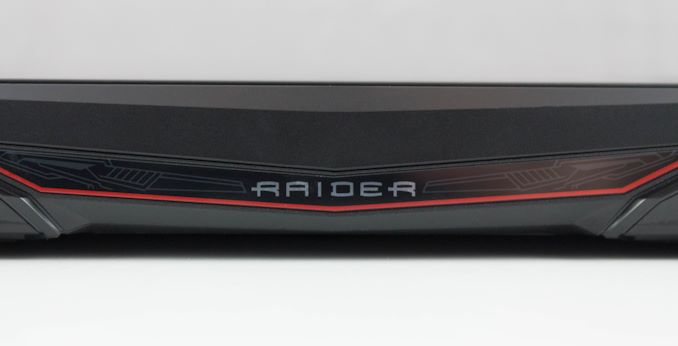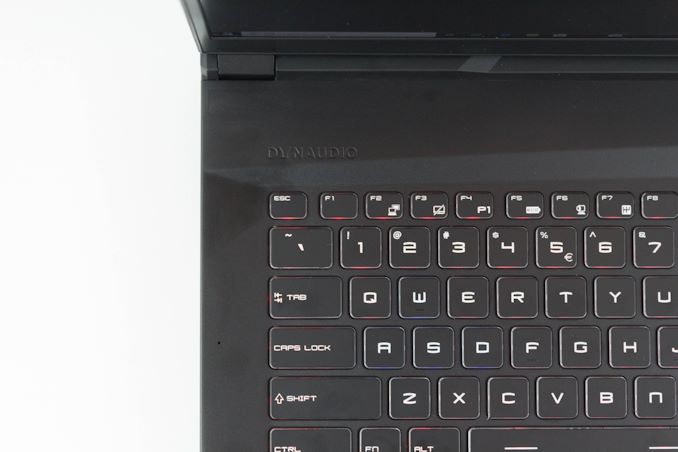The MSI GE75 Raider Laptop Review: Core i9 and RTX 2080 Performance
by Brett Howse on July 12, 2019 8:00 AM ESTFinal Words
MSI has been laser focused on the gaming market for several years, and have been one of the manufacturers to see the growth potential that the gaming market provided. Their laptops share a similar design philosophy, and offer one of the most premium takes on the gaming laptop market around. The GE75 Raider continues that trend, offering much of what the GT series provides, while coming in at hundreds of dollars less than the GT range, and offering a laptop that is much more portable than the GT lineup, which is MSI’s desktop replacement lineup.
The aluminum top shell and keyboard deck provide the premium metal feel you’d expect, while the plastic bottom doesn’t get in the way since most of the time you’ll never see it. The red accents on the lid, coupled with MSI’s dragon logo, are subtle enough that the styling works quite well, while still keeping this laptop looking like it is cut from the same cloth as MSI’s other gaming systems.
Opening the lid, the GE75 Raider sports the modern thin bezel design, and features on the of the best keyboards around, with per-key RGB backlighting and plenty of customization. The SteelSeries keyboard offers great feel, and while the key caps could be better, it still offers a great experience, especially coupled with the generously sized, and accurate, trackpad.
Gaming laptops are all about performance, and the GE75 Raider delivers in spades. It features the first eight-core CPU we’ve ever tested in a notebook, and even the base model ships with a very stout six-core unit. The Core i7-9750H and Core i9-9880H both provide plenty of grunt to keep the GPU fed.
NVIDIA’s latest GPU lineup for laptops doesn’t offer the same performance jump from the previous generation that we’ve come to expect, but the RTX 2060, 2070, and 2080 offered in the GE75 Raider still provide the most single-card performance available in a laptop. MSI’s GE75 Raider is large enough that they don’t need to use the Max-Q designs either, meaning you’re seeing more performance than you’d see on thinner and lighter gaming laptops, with of course the tradeoff of mobility.
The 1920x1080 144 Hz IPS display is a masterpiece, offering some of the best color accuracy we’ve seen on any laptop, and MSI’s True Color software lets you easily customize it as needed for practically any scenario. The one missing feature is G-SYNC though, with MSI choosing Optimus over G-SYNC, and in a gaming laptop, that’s likely the wrong choice. Gaming is still smooth, thanks to the 144 Hz display, but variable refresh rate is a wonderful technology that is sadly missing here.
The tradeoff of G-SYNC should be better battery life, but MSI only outfits the GE75 Raider with a 65 Wh battery, and as such the battery life is middling at best, which is expected in something targeted at gaming. The Optimus isn’t enough to overcome the smaller battery, especially when the competition from Acer offers the user a choice of G-SYNC or Optimus through a hardware multiplexer, which is a solution any gaming laptop manufacturer should emulate.
But the overall GE75 package is solid. The performance is top-notch. The design is pleasing and functional. The keyboard customization is wonderful. MSI tends to charge a premium for their machines, and that trend does continue here, but thanks to the wide range of options, the GE75 Raider fills a pretty wide range of budgets, from $1799 at the bottom end to $3399 at the top, and even the bottom end of the range still comes with a respectable 512 GB of NVMe storage, a Core i7-9750H, and 16 GB of DDR4. At the top, the pricing is high, but MSI continues to showcase their excellent design and execution, with the GE75 Raider being a worthy contender.













30 Comments
View All Comments
gunnys - Friday, July 12, 2019 - link
The current lack of 4K 17.3" gaming laptops is depressing. We have faster hardware but low res displays.DanNeely - Friday, July 12, 2019 - link
As noted in the article itself, MSI is currently limiting the 17" 4k option to their even higher end and chunkier GT76 series.gunnys - Friday, July 12, 2019 - link
I missed that, thanks for the heads up. But I also meant in general, lack of 4K sucks. I spend way more time not gaming than gaming, and would appreciate higher pixel density in general tasks. Personally I'd be more pleased with 4K at even just 60 Hz. A 120 Hz or 144 Hz panel would be useful just a few hours a month in gaming.And the whole situation makes even less sense when I'm seeing plenty of 15.6" 4K laptops.
I've heard the new Razer Blade Pro will only ship with 4K in it's upcoming Quadro RTX version. It appears manufacturers are reserving 4K for the highest tier only. In that case.... I'll hold off on buying. I don't need a Quadro or a $4000 laptop... just more pixel density. An RTX 2080 or Quadro isn't needed to drive Windows, Office, and Youtube at 2160p.
A decent 17.3" 4K panel wasn't a huge upgrade cost just a year or two ago.
DanNeely - Friday, July 12, 2019 - link
as an ever more niche product line 17" laptops tend to lag badly in any components (like screens) that can't be shared with more plebeian 15" laptops. Volumes of high end 13 laptops are higher than 15" and 15" is higher than 17"; with the result that most of the higher end screen options started at the smallest size where there was more volume to be sold and then worked their way to smaller volume parts only slowly.When I get my next laptop in a year or two I'm hoping to be able to find something with 1440p/144hz at 15". 4k's massive overkill, drives up power consumption. 1440p is good enough for general use and is at least somewhat plausible to game at above 60hz on the occasions I do that instead of just surfing the web.
quiksilvr - Friday, July 12, 2019 - link
I would say not having G-SYNC is the bigger issue.tshoobs - Wednesday, July 17, 2019 - link
I agree that it is sad to still see so many gaming laptops in this class using 1080p - that is really not enough pixel density for a 17.3" screen.For general use, 4k resolution in this screen size still generates a lot of need for scaling which in Windows is as good as it has ever been but still flawed.
I'd love to see a 1440p panel however, I think that would be perfect for the 17.3" gaming laptop. 1080p is very long in the tooth.
ingwe - Friday, July 12, 2019 - link
Given that it is a 144 Hz IPS display with great color accuracy, I think it is still a display to be happy with.weilin - Friday, July 12, 2019 - link
I'd personally prefer QHD (2560x1440) over UHD. Especially for screens smaller than 24". It seems like the best compromise on resolution and performance.quantumshadow44 - Friday, July 12, 2019 - link
Im perfectly fine with 4k on 15" dell m4800.100% srgb/Adobergb
pbollwerk - Friday, July 12, 2019 - link
My current laptop (Alienware 13) has the "near"-4k OLED, and while it looks gorgeous, I don't like the performance hit I get when gaming, and text is unreadable. Maybe 4k is better on a 17", but my next gaming laptop won't be 4k. For gaming, it's not worth it for me.For other tasks, like video/photo editing, I can understand. But this is a gaming laptop.
Having said that, 1080 is too low resolution for modern laptops.